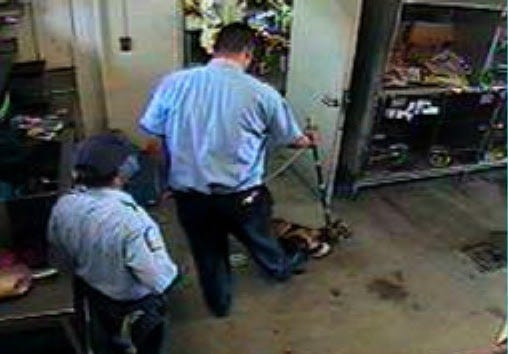A dog in a filthy kennel at Los Angeles County Department of Animal Care & Control.
Shelters across the country are complaining that they are at overcapacity. A coalition in South Carolina has even declared a “state of emergency.” A spokesperson put it in stark terms: “The lives of thousands of animals in shelters across South Carolina are at stake.”
While shelters are blaming the public by saying they are surrendering animals in droves, the data tells a very different story. Pet Point, a shelter management software used by thousands of shelters and rescue groups across the country, recently revealed that intake numbers are still below pre-pandemic levels. “Looking at this data,” Pet Point’s Vice-President writes, “it doesn't look like it's being driven by extraordinary intake, as many have perceived.” Given that intakes are still below pre-pandemic levels, why the logjam?
The Pet Point analysis suggests an answer: inefficiency. Shelters have not returned to pre-pandemic staffing and practices. Many shelters have still not fully opened to the public for adoption. That means animals are not going out the front door as fast as they could. And not only are some shelters refusing to fully open to the public, some — like the Los Angeles County Department of Animal Care and Control — have announced that they never will.
The department recently issued a report to the Board of Supervisors informing them that, if approved, they will no longer allow members of the public to visit county shelters to look for and reclaim lost pets, adopt new ones, rescue them from death, or just visit and play with the animals, unless those individuals have scheduled an appointment to do so. The department has the support of national groups like Best Friends Animal Society and the ASPCA, which are encouraging other shelters to adopt similar policies.
While shelter management in Los Angeles County claims that this “appointment only” policy will increase lifesaving (somehow), reduce intakes, and reduce stress for animals by limiting activity and noise levels, this is misleading. For animals, visitors mean stimulation, walks, getting played with, and finding homes.
At the same time, the “appointment only” policy reduces their chance of being adopted and, in a regressive shelter, this is often a death sentence. According to a shelter watchdog and critic of the new policy, “At Los Angeles County Animal Care and Control, numerous people complained about the shelter not returning their calls when they tried to make adoption ‘appointments.’” The same issue is arising on the other coast in New York’s equally dysfunctional and regressive animal shelter. One family attempted “to adopt a dog from [New York City Animal Care and Control] NY ACC, [but their…] application was ‘pending’ for weeks before [that family] repeatedly called the shelter to get them to respond.”
This “appointment only” policy has also been criticized because it locks out “poor people and older people who don't have or are unable to use online services” from adopting, costing them and the animals a loving companion. It also erases tremendous gains made by the No Kill movement over the last decade to force greater public access, as well as to force better and more sensible adoption/reclaim hours, all of which have been key to reducing shelter killing nationwide.
But there’s another reason why closing doors to the public is so dangerous for animals: public scrutiny keeps neglect and abuse in check. Rescuers, potential adopters, volunteers, and other members of the public are the eyes, ears, and heart of the community. If they are not allowed to visit the facility unannounced, animals will suffer in silence. That’s not conjecture; it’s history.
Abuse Thrives in Darkness
A rabbit furiously tries to drink water from an empty container at the Los Angeles County Department of Animal Care & Control.
The staff called it “Spinal Monday.”
Several years ago at the Los Angeles County pound, a volunteer found a rabbit in a back room outside of public view who was suffering from an exposed spine and being cannibalized by other rabbits. A subsequent investigation uncovered that the rabbit had been left alive in her cage for one week in that condition. Also discovered in the cage was a dead rabbit, his decomposing body covered with flies, and another rabbit with an eye popping out of his socket who was being attacked by the others. None of these animals had food or water. “Shelter” employees claimed to be unaware of these conditions, even though they were required to clean the cages every day. Out of public sight is out of mind for staff. During an unannounced visit to the same facility two years later, attorneys from The No Kill Advocacy Center found filthy rabbit cages and empty water bowls, apparently once again “forgotten” in an out-of-the-way back room.
Los Angeles County Department of Animal Care & Control officers kicking a dog restrained with a hard-wired noose around his neck in a backroom.
These are not anomalies. Under current Los Angeles County management, animals have been starved to death; cats have contracted panleukopenia because they were not given an examination, treatment, or vaccinations on intake; animals have been left with torn ears and gouged eyes without rehabilitative care; and animals have been warehoused in filthy conditions. There’s more, including staff physically assaulting animals and staff simply clocking-in and then going home, getting paid for sleeping on the clock, while animals are left in need. While many of these problems occurred years ago, others are more recent.
Mr. Pickles, for example, was a young, healthy cat who was surrendered by his family to the L.A. county pound system. He was placed in what is known as the “feral” building. The building is behind a locked gate, inaccessible to the public. There, healthy cats like Mr. Pickles are housed next to sick cats, ensuring that those who enter healthy don’t leave that way, if they leave at all.
Mr. Pickles turned out to be very sweet, rubbing up against the bars of his cage when staff walked by and calling out to them with a soft meow. He was so pliable, in fact, someone put a pair of Mr. Potato Head glasses on him and snapped his photo to show others how cute he was. A volunteer who was given permission to enter the building to pick up a different cat took a video of Mr. Pickles being friendly. She, too, saw immediately that despite being labeled “feral,” Mr. Pickles was social with people. She had hoped the video would get him moved to a public building for adoption. Others tried too; one of them writing in large block letters on his cage card: VERY SWEET CAT.
Despite these attempts, staff at the pound killed him with a lethal dose of barbiturates. In a bid to cover up the malfeasance, Mr. Pickles was labeled “unadoptable.” “I have personally verified and therefore, recommend based on the criteria in OPK 120, that this animal is eligible for PTS,” a staff member wrote on his official paperwork. PTS — meaning “Put to Sleep” — is a euphemism for killing. OPK 120 is the policy that authorizes the killing of cats who are alleged to have “a behavioral or temperamental defect that could pose a health or safety risk or otherwise make them unsuitable for placement as a pet.” According to the pound director, cats are only killed in cases of “severe injury, untreatable illness, or dangerous/wild temperament,” a claim no one believes; including, I suspect, the shelter director herself.
Mr. Pickles was not injured. He was not ill. He was not dangerous. And putting aside how cruel it is to kill cats even if they truly are “feral,” Mr. Pickles was not. It was quite literally written on his cage. But according to a whistleblower, mislabeling cats is something that “happens a lot.” It’s easy to do when animals are hidden away from public view. The only reason we know of Mr. Pickles is because of a whistleblower, who has since gone silent because their job was threatened. Without public oversight, shelter staff will have even fewer practical limits on their power to neglect, to abuse, to kill, and to lie about it. Any animal that enters the Los Angeles County system faces the same fate as Mr. Pickles.
A Mission Betrayed
A severely injured dog dragged across the pavement by Los Angeles County Department of Animal Care & Control officers. The dog was subsequently killed.
Across the country and over the past 20 years, one primary thing has forced regressive shelters to improve: the court of public opinion. When the public hears about neglect, abuse, and killing in their local shelter, they denounce it and demand changes. It is no surprise then that regressive, historically abusive pound systems like those in Los Angeles and New York would reject transparency and accountability by closing their doors to the unannounced public.
It is equally not surprising that large, national groups like Best Friends and the ASPCA, are endorsing the effort. Like the ASPCA, Best Friends has a long history of corruption, including but not limited to:
Defending shelter directors who killed animals in the face of a rescue alternative.
Opposing efforts to mandate public-private partnerships between municipal pounds and non-profit No Kill organizations that would have saved roughly 25,000 animals a year in New York.
Protecting shelter management in the City of Los Angeles when that shelter was killing community cats and opposing litigation that would have forced them to stop.
Falsely claiming Los Angeles city shelters are No Kill, shielding them from scrutiny for abandonment, killing, neglect of duty, and threatening to arrest rescuers.
And promoting policies at shelters intended to silence rescuers and volunteers.
Their embrace of diminished transparency and accountability is par for the course.
A Worrying Trend
A cat abandoned in the parking lot of Los Angeles Animal Services when the person trying to surrender him was turned away because the pound closed its doors for much of the year. A rescuer trying to help the cat was told by staff that she needed a permit to trap him, would not be given a permit, and was not allowed to even provide food or water on threat of prosecution. Other shy cats were not so “lucky” as the pound was under a court order to kill even healthy “feral” cats. And yet, Best Friends falsely claimed that the city is No Kill.
In the past two decades, shelters that have fully invested in lifesaving — comprehensively implementing the programs and services of the No Kill Equation — have achieved placement rates greater than 95% and as high as 99%. Collectively, these achievements have helped lead to a decline in killing nationwide of 90% from its high water mark of 16 million in the 1970s. It has been called “the single biggest success of the modern animal protection movement.”
But that puts organizations and shelters that have not embraced comprehensive reforms at a terrible disadvantage and under greater public scrutiny. By turning away animals in need, including blind cats found walking around lost in circles; refusing lost dogs, telling finders to release them back on the street; failing to pick up kittens left abandoned on sidewalks; and more, these shelters can claim reduced intakes and higher placement rates, improving their statistics at the expense of animals.
For this reason, higher “placement rates” are no longer a guarantee of a job well done. Instead of evidence of hard work and a commitment to No Kill, these numbers can be the result of turning people and animals away, mischaracterizing animals like Mr. Pickles as a threat to public safety, limiting the flow of incriminating information by hiding abuse from the public, and threatening rescuers and volunteers who would otherwise expose inhumane conditions or other mistreatment.
And it is by design. Indeed, that just may be how Best Friends intends to (falsely) claim America has achieved a No Kill nation, something it is promising will occur by 2025, all so that it can fundraise from a caring, but unsuspecting, public to the tune of tens of millions of donation dollars every year.
To prevent this sham, we must open the shelters fully to the public and to the light of public scrutiny. Transparency is not only the best disinfection against corruption, without it, the animals perish.

















